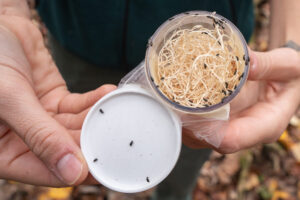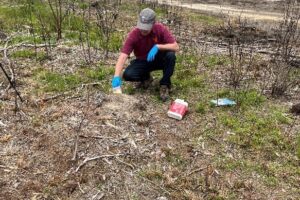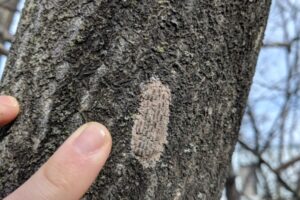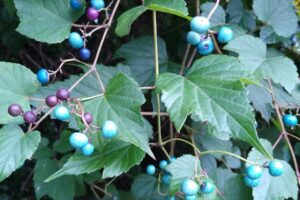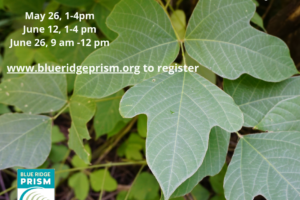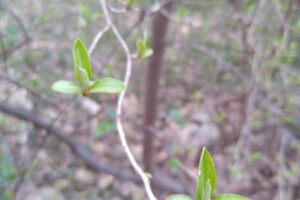Field Notes
December 9, 2022 -
By Cory Swift-Turner, Communications Specialist Eastern hemlock (Tsuga canadensis) is a coniferous tree that favors the cool and humid climate along the Appalachian Mountains. Hemlocks can grow more than 150 feet tall and live for more than 800 years. Their short, dense needles provide excellent habitat for many kinds of wildlife, from warblers to bobcats. Unfortunately, healthy hemlocks are becoming increasingly rare. In the early 1950s, an invasive insect called... Read More
Field Notes
June 9, 2022 -
By Amanda Conrad, VDOF Forest Health Technician The vibrant, metallic green of an emerald ash borer (EAB) makes it look like royalty of the forest. But this beautiful, invasive insect is also deadly. Just one beetle can lay 40-70 eggs on the bark of its preferred host: ash trees. The growing larvae disrupt the flow of water throughout the tree, which will ultimately kill the tree. A healthy ash tree... Read More
Field Notes
May 26, 2022 -
By Katlin Dewitt, VDOF Forest Health Specialist Can a fire alarm alert you to an invasive insect? Technically, no, but it seems an appropriate way to raise awareness about the red imported fire ant! The red imported fire ant (RIFA) is native to central South America and was first detected in either Alabama or Florida between 1933 and 1945. In Virginia, this species was first detected in 1989, and so... Read More
Field Notes
February 23, 2022 -
By Lori Chamberlin, VDOF Forest Health Manager If you are in search of a fun winter activity, look no further! The spotted lanternfly (or SLF, for short), an invasive insect that was discovered in Virginia in 2018, continues to spread, and we need your help finding egg masses. Spotted lanternfly egg masses are laid in the fall, survive through the winter, and then hatch in the spring. Each egg mass... Read More
Field Notes
September 29, 2021 -
By Ellen Powell, VDOF Conservation Education Coordinator I know what you’re thinking. But no, the vine that ate Charlottesville isn’t kudzu. It’s porcelain-berry (Ampelopsis brevipedunculata). You might know this species as an ornamental vine, often seen spilling over pergolas in fancy gardens. It’s great for covering a bare patch of ground or an unsightly old shed. The fruits are quite beautiful, with pale green, lavender, magenta, and blue berries often... Read More
May 11, 2021 -
Blue Ridge PRISM’s Summer Invasive Plant Workshop (virtual) will help you learn to identify and manage those invasive plants that are best controlled during the summer months. Topics covered in this session include: Identifying invasive plants Which invasives you can best kill now Which invasives you should treat later Best seasonal practices for each invasive Using manual and mechanical control methods Methods for controlling invasives with herbicides Choosing the right herbicide... Read More
May 11, 2021 -
Blue Ridge PRISM’s Summer Invasive Plant Workshop (virtual) will help you learn to identify and manage those invasive plants that are best controlled during the summer months. Topics covered in this session include: Identifying invasive plants Which invasives you can best kill now Which invasives you should treat later Best seasonal practices for each invasive Using manual and mechanical control methods Methods for controlling invasives with herbicides Choosing the right herbicide... Read More
May 11, 2021 -
Blue Ridge PRISM’s Summer Invasive Plant Workshop (virtual) will help you learn to identify and manage those invasive plants that are best controlled during the summer months. Topics covered in this session include: Identifying invasive plants Which invasives you can best kill now Which invasives you should treat later Best seasonal practices for each invasive Using manual and mechanical control methods Methods for controlling invasives with herbicides Choosing the right herbicide... Read More
Field Notes
March 31, 2021 -
By Ellen Powell, VDOF Conservation Education Coordinator With recent warm weather, Virginia’s woods are greening fast. After a dormant winter, plants gear up for photosynthesis again, using carbon dioxide, water, and sunlight to make food. You might be familiar with some early spring wildflowers that emerge on the forest floor, taking full advantage of the leafless canopy to gather some sun of their own before being shaded out by trees.... Read More

